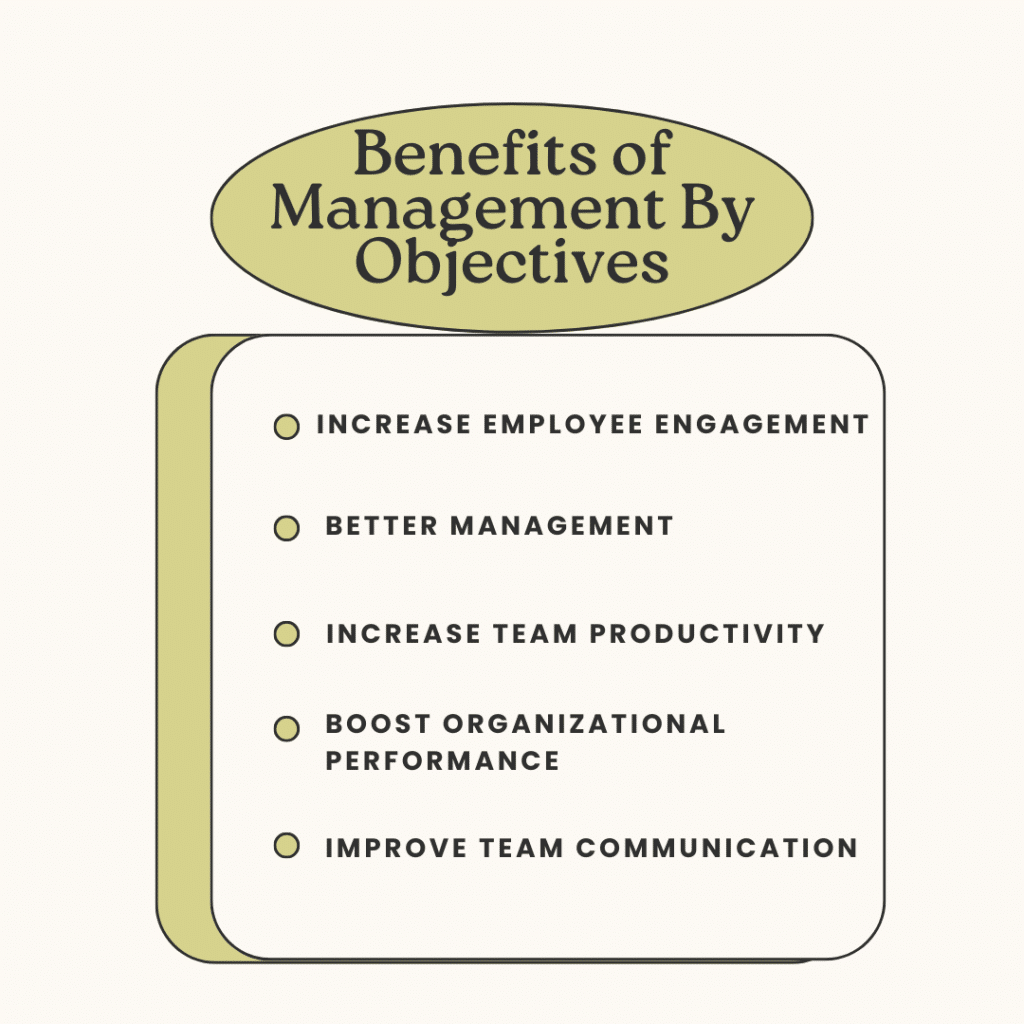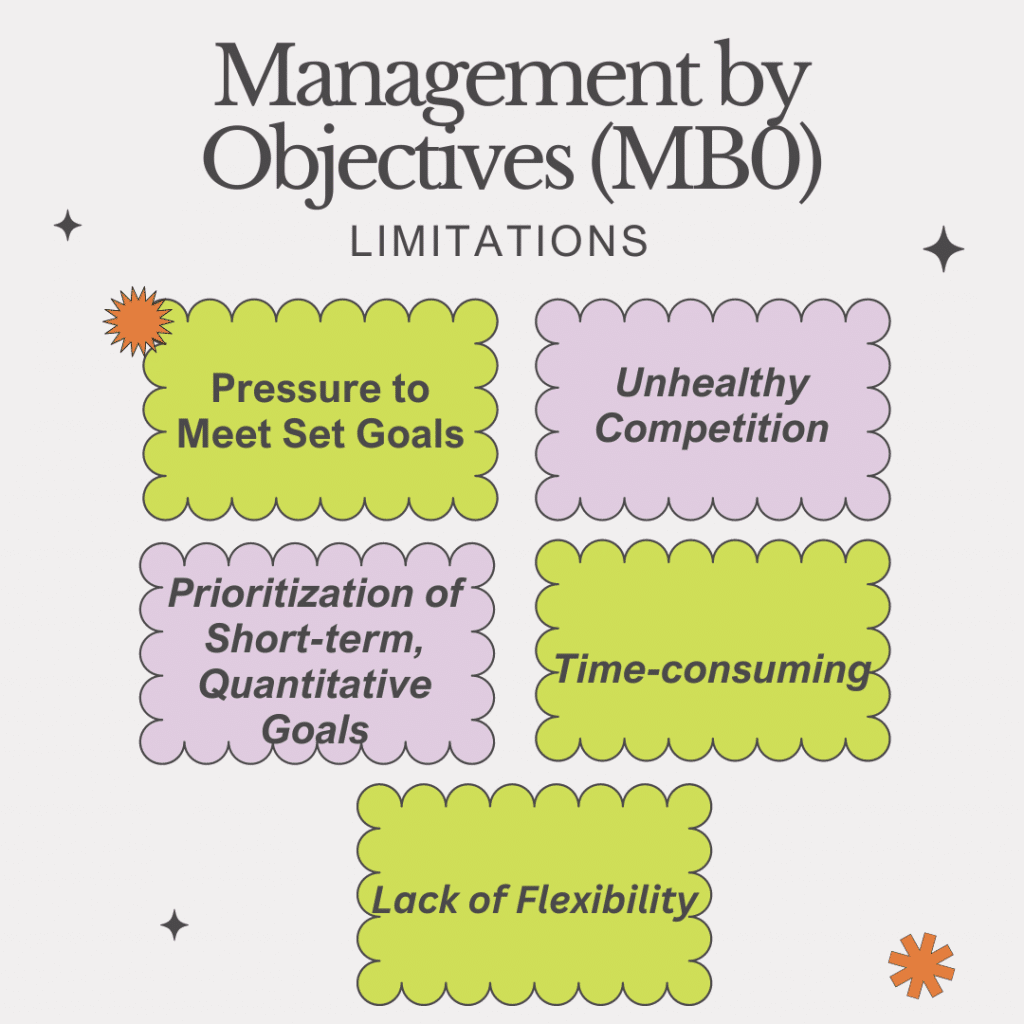Management by Objectives (MBO) is a leadership management approach that every leader must employ to manage their team’s performance and efficiency effectively. This approach entails setting and aligning SMART goals to achieve business objectives. I once led a team with big dreams but struggled to turn them into reality. That’s when I stumbled upon MBO, and it has guided me to set and align the efforts of everyone on my team to achieve the company’s set objective.
Let us go into the details of using MBO to set goals toward achieving business goals.
Key Takeaways
By establishing specific, quantifiable goals, Management by Objectives (MBO) is a leadership strategy that enables leaders to align team efforts with organizational objectives. MBO improves communication, productivity, and employee engagement by encouraging involvement, offering frequent feedback, and embracing flexibility. This eventually leads to organizational success.
What is MBO?
Every business has set goals and objectives it hopes to achieve as it grows. So management by objectives is a leadership management technique that a business uses to set SMART goals, align them with the employees, and monitor the progress of such goals. Here, the employee will then align their own goals with those of the company.

Photo Credit: CFI
The management by objectives management style defines goals, outlines action plans, and reviews and evaluates performance to ensure alignment of objectives with company goals, and overall strategy
MBO is a roadmap to success. It’s a strategic approach to goal setting that takes your “big-picture” dreams and breaks them down into clear, actionable steps for everyone in your organization
Brief History of MBO
Peter Drucker introduced the concept of management by objectives in 1954 in his 1954 book “The Practice of Management.” Drucker advocated for a more collaborative approach that is focused on setting clear objectives and empowering employees to achieve them.
During the 1970s and 1990s, management by objectives became more recognized, especially in large corporations. These companies realized that there was an increased demand for a more systematic approach to management.
However, criticism of the concept arose by the mid-1990s; most critics believed that companies were becoming more bureaucratic and that most companies also relied heavily on short-term goals.
Management by objectives emphasizes goal clarity, employee engagement, and performance accountability, which continues to resonate with managers, who want to be successful in the changing business world. So, despite criticisms, management by objectives remains a relevant and widely utilized management approach.
MBO continues to be used but with a more modern approach. Organizations recognize the need for flexibility and adapt MBO to fit their specific needs.
Key Elements of MBO
- Clarity and Measurability: One of the great elements of MBO is the setting of clear, specific, and measurable goals. It becomes the foundation for every other element.
- Participative Goal Setting: MBO also stresses participative goal setting, by encouraging managers and their employees to work together when defining business objectives that align with both their individual objectives and company goals
- Performance Evaluation and Feedback: MBO also advocates for regular performance evaluation and feedback mechanisms to track the progress of set objectives, identify areas for improvement, and recognize achievements.
What is the Goal of MBO?
At first, MBO seemed like a lofty concept, wrapped in mystery and jargon. But as I delved deeper, I realized it’s all about setting clear, measurable objectives that align with organizational goals. It’s like setting out on a journey with other people while you make sure that everyone knows exactly where we’re headed and how we’ll get there.
MBO ensures that employees are communicated with regarding their roles and responsibilities, while also ensuring that they understand the role they play in the overall health of the organization. This guides them on what the business expects from them and also gives them a sense of purpose and ownership as they help the business fulfill its set goals.
During my company’s weekly meeting, our CEO once discussed at length the business’s 20-year plan and the various “big” goals and objectives we have to implement to achieve that long-term strategy. At first, I felt overwhelmed, but as he broke them down into smaller goals, it became clearer and easier to understand, and then I was given a certain task to carry out concerning those goals.
Benefits of Management By Objectives (MBO)

- Increased team productivity: When team members and employees know a business’s objectives, then they perform their job roles with more clarity. As a result, their motivation and productivity will also increase.
- Improved team communication: Management by objectives improves the communication model of an organization. It creates an open work environment where goals and challenges are easily communicated without fear or prejudice.
- Motivation and Morale: Because MBO improves communication between managers and employees, interpersonal relations, motivation, and morale will also improve as everybody is fully involved in achieving business goals.
- Improves organizational performance: By setting clear and measurable objectives, while also aligning such goals with employees’ individual goals, such employees become motivated to work to achieve them, further leading to increased productivity. This will boost the overall business performance
- Increases employee engagement: When an organization involves their employees in the decision-making process of the company, it increases their engagement levels as they feel that they have become a part of the organization, and are motivated to give the company their best.
Limitations of Management by Objectives

- Pressure to meet set goals: Because MBO focuses on the individual, team members may feel too much pressure to reach their goals. This can be a drawback of MBO because team members may become overworked in this type of work environment, which can lead to low retention and low morale.
- Competition between team members: Since rewards and recognition are based on performance, the workplace can become too competitive for the employees. Instead of promoting teamwork and collaboration, employees will focus more on becoming the best, and this unhealthy competition might not be good in the long- run
- Overemphasizes short-term, quantitative goals: MBO prioritizes short-term, quantitative goals over long-term strategic ones. Managers may not prioritize other qualitative long-term goals needed for the overall success of the company. Businesses also need to make long-term qualitative goals a priority if they want to experience growth.
- Time-consuming: The regular meetings that are needed to set these goals and perform evaluations can distract attention away from other important commitments of both individuals and the business. To make the process less cumbersome, create other avenues that can simplify and clarify each process for easy communication and feedback
- Lack of flexibility: “The MBO approach, which relies heavily on objectives and action plans, offers structure but may hinder adaptability in dynamic workplaces. It is important to encourage employees to explore alternative approaches that can enhance flexibility. Although MBO advocates close progress monitoring by managers, businesses should empower employees to take ownership of their tasks, which remains essential.
The Five (5) Steps for Implementing MBO

#1. Define Organizational Objectives
What objectives do you want to achieve as a company? What is the time frame? The first course of action is to define your organizational objectives. You can create goals for the different stages of your business.
#2. Translate Organizational Goals to Employees
As a business leader, you should share these goals with everyone in your organization, just like my boss did. Furthermore, you have to know how your employees, with their different skill sets, can help your organization achieve its set goals and objectives. Make sure you’re using the SMART goals framework to ensure your team members’ goals are measurable and achievable.
#3. Monitor Performance
Conduct a regular review of your employees’ performance. Are they meeting up with their assigned target? In my office, we have “Monday meetings,” where everyone gives an account of the previous week’s task and any other challenge that was encountered in the process of carrying out the week’s job roles.
When you monitor team member performance, it will also help you know how productive your employees and team members are.
#4. Evaluate Progress
You should gauge employee performance, identify key areas for improvement, and then offer personalized feedback to help your employees excel. The feedback should either be positive or constructive. Positive feedback should be given openly to inspire others, while constructive criticism should be provided privately to avoid embarrassment. If employees are struggling to meet their goals, it may be due to a lack of clarity or inadequate resources. Addressing these issues means ensuring that goals are clear and employees have the resources they need. This improves communication and boosts team productivity.
#5. Reward Accomplishments
The final step in MBO is recognizing and rewarding achievements. This boosts morale, motivates them, and keeps them excited for future projects.
Rewards can be intangible (recognition, team-building activities to foster self-confidence and motivation) or tangible (offering praise, bonuses, promotions, or paid time off). Both types incentivize continued effort toward achieving individual and company goals.
One of the most rewarding aspects of our MBO journey has been celebrating our achievements. From reaching quarterly targets to launching successful projects, each milestone is a buoy marking our progress toward our ultimate destination—success.
#6. Review Goals
As an additional step, since MBO is an ongoing process, you should regularly monitor progress and provide feedback to your team. Always check to make sure you are on track. Management by objectives requires continuous effort because company objectives will change as they grow Check to see if your goals need to be adjusted based on new information or changing market conditions. Remember, flexibility is key!
Examples of Using MBO
The following are some of the ways businesses can use and implement MBO to set goals:
| Sales Industry Define Goals Increase the overall sales revenue by 10% in Q3 Develop targeted marketing campaigns and sales training programs. Action Plan Expand client base through networking events Track sales figures, analyze marketing effectiveness, and monitor incentive programs. Evaluation Compare actual sales to target goals. Recognize top performers, identify areas for improvement in training or marketing, and adjust incentives Feedback Identify areas for improvement in sales tactics. | |||||
| Marketing Industry Define Goals Increase Brand Awareness Increase social media engagement and collaborate with sales to qualify leads Action Plans Launch social media ad campaigns targeting specific demographics. Collaborate with influencers for product endorsements Evaluation Conduct surveys to measure brand recognition and perception. Track leads generated, monitor social media engagement, and evaluate conversion rates Feedback Gather team feedback on campaign effectiveness and collaboration Provide feedback on campaign effectiveness, analyze content engagement, and improve lead qualification processes | |||||
| Human Resources Industry Define Goals Reduce Employee turnover Improve Employee Development Action Plans Conduct exit interviews, implement employee engagement programs, and offer competitive compensation. Develop employee training and development programs aligned with career growth goals. Evaluation Track employee turnover rates and monitor engagement survey results. Review employee performance evaluations and career progression. Feedback Identify reasons for turnover, evaluate engagement programs, and adjust initiatives or compensation packages. Provide feedback on training effectiveness and opportunities for growth identified in performance evaluations. | |||||
| Manufacturing Industry Define Goals Improve Production Efficiency Action Agendas Implement lean manufacturing principles to streamline processes and reduce waste. Invest in automation technologies for repetitive tasks and assembly lines. Evaluation Monitor production output and cycle times. Conduct quality control inspections and analyze defect rates. Feedback Provide feedback on the effectiveness of lean manufacturing initiatives and identify areas for further improvement in efficiency. Recognize teams for achieving production goals. | |||||
How to Overcome Challenges in MBO Implementation
Every journey has its challenges, nevertheless, there will always be a solution. One time in my career, some of my team members were skeptical of implementing a new approach So, when I gently explained the benefits of implementing this new approach—increased productivity, clearer communication, and a sense of ownership over our goals—I was able to win them over.
Lack of clarity is one of the challenges that an organization can encounter when implementing MBO. This is because if some employees do not understand what they are supposed to achieve, then there is a chance that it will be difficult to implement MBO. In addition to the above, some of the employees may be scared to embrace a new way of doing things, and this can hinder the implementation of MBO.
Finally, not having adequate tools to track and evaluate your goals can hinder the successful implementation of MBO.
Despite all these challenges, there are ways to address them. They include
- Effective communication: To successfully implement MBO, ensure you communicate effectively, clearly define the goals for every party, and make sure they have the needed resources. This will ensure that everyone knows what they are going to do.
- Education and active participation: address resistance by explaining to every party involved the benefits of implementing. You can also encourage active participation and ensure you celebrate every win. This will boost morale and productivity
- Invest in the Right Tools: Implementing MBO without the right tools is a challenge that can be solved by ensuring that the business invests in the right tools, and also provides training resources for the employees to gain technical knowledge on how to use tools. For example, you can invest in CRM tools, project management tools, etc.
What is Management by Objective (MBO)?
Management by Objectives is a strategic management approach where a business and its employees set specific goals, plan actions to take for such goals, monitor progress, and provide feedback that aligns with employees and business goals.
What are the 5 Steps of the MBO Process?
- Set goals
- Develop action plans
- Implement plans
- Monitor progress
- Evaluate and provide feedback.
What are the Benefits of MBO?
MBO enhances goal clarity, employee accountability, performance improvement, and organizational alignment, fostering a culture of continuous feedback and achievement.
Additional Resources
- Management by Objectives: The Peter Drucker Practice by Peter F. Drucker
- Setting Goals: Getting Everything Done by Michael Hyatt
- SMART Goals Guide
Conclusion
MBO is a useful tool that businesses can use to improve performance and achieve goals. When you embrace MBO, you can transform your organization’s culture, leading to increased productivity, improved morale, and sustainable growth. Business leaders can effectively implement MBO by understanding the process, benefits, and challenges. Have you tried implementing MBO in your organization? Share your experiences and insights in the comments below! What challenge(s) did you also face, and how did you resolve them? Feel free to drop your answers in the comment section below.
- WHAT IS MANAGEMENT BY EXCEPTION?
- Leveraged Buyout Model: Definition, Types & Examples
- Management Buyout: Guide To The Management Buyout Process & Financing
- Everything You Need to Know About Marketing Objectives






